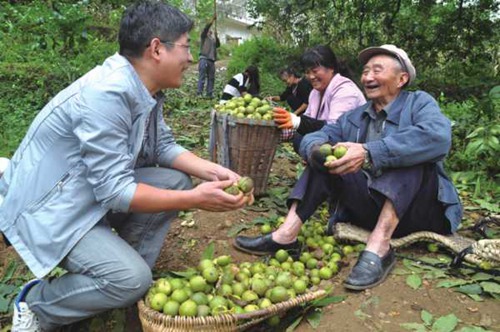In Hezhang, small walnuts means big profits
China Daily, November 14, 2016 Adjust font size:

Pan Xuejun (L), a walnut growing expert, talks about the yield of walnuts with local farmers in Hezhang county, Guizhou province. [Photo/zgqxn.com]
For many people living in Hezhang county, the walnut is not only a tasty treat, it is also the gateway to prosperity.
The lucrative earnings from walnut farming have helped lift people out of poverty in the county in Southwest China’s Guizhou province – but it hasn’t always been that way.
Ten years ago, there was only 140,000 mu (9,333 hectares) of walnut growing areas in the county. Lack of technology, innovation and cooperative farming mechanisms had stifled industry growth, despite the long sunshine hours, high elevation and warm temperatures enjoyed by the area making it highly suitable for walnut farming.
Professor Pan Xuejun, who has been dubbed “Walnut Pan”, began working in the county to improve the industry a decade ago after study walnut trees during his doctorate degree studies in North West Agriculture and Forestry University in 2005.
Thanks to Pan’s efforts, the total growing area now stands at 1.66 milion mu, which generates as much as 1.5 billion yuan ($220.48 million) annually, depending on crop success.
Pan still remembers the first day when he conducted a survey in Caishen village. A villager learned that he was studying walnut growing and invited him, enthusiastically, to have lunch with him. He laid out the best food he had at the time – a bowl of potatoes, a bowl of cabbage and a mix of corn flour and rice.
“The villager reminded me my father who is kindhearted and hardworking but cannot find out way to get rid of poverty,” Pan said as he recalled the day. He said the scene made him determined to stay in the county to help the locals live a better life.
To choose the better varieties of walnut, Pan visited 88 counties and cities in Guizhou and developed grafting technology. While also teaching at Guizhou University, Pan cultivated approximately 1,500 technicians to help him promote the use of modern technology among farmers around the county.
“Grandpa” Chang is an 83-year-old resident of Caishen village who has been involved in walnut farming for years. Age has rendered him less mobile than he once was, but he still loves to sit beside the road and watch his grandson beat walnuts out of the tree with a stick. Walnuts are his major source of income now, thanks to the aid of Pan’s technological guidance. Each tree can yield as much as 7,000 yuan each year, and see him comfortably into retirement.
Li Fuzhui, a walnut grafting technician, used to live in poverty and can now make an annual income of 60,000 yuan after setting up a walnut garden under the help of Pan.
Stories like Chang’s and Li’s are very common in Hezhang. By growing walnuts improved by Pan, locals made more money to renovate houses, buy cars and live an easier life.
However, Pan has not stopped his step to develop walnut growing technology.
“Expanding planting areas is not my final goal; I want to improve yield profit and grow better varieties.”